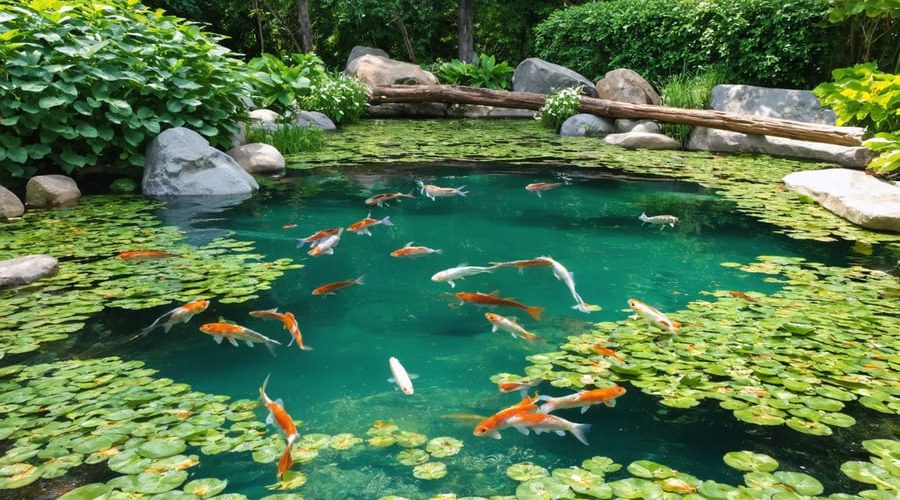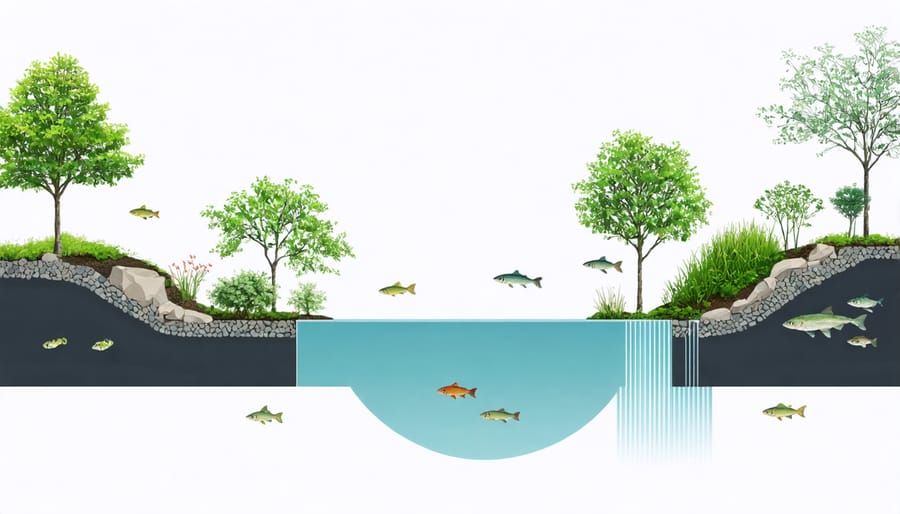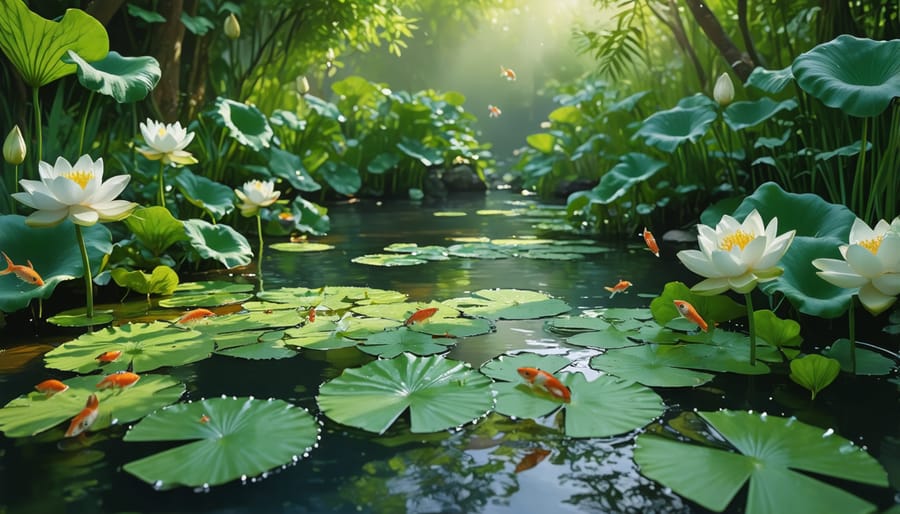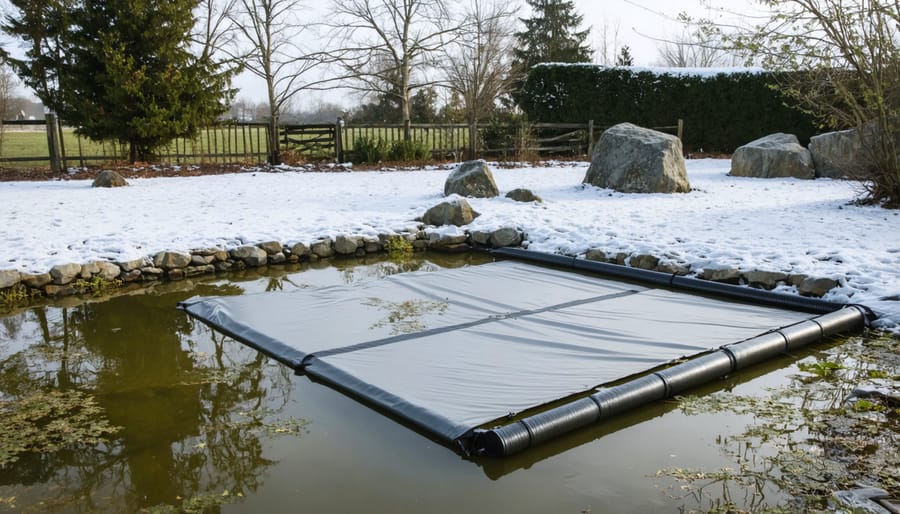
Transform Your Fish Pond into a Thriving Natural Paradise
Transform your backyard pond into a thriving fish habitat by creating deep zones of 4-6 feet for temperature stability, establishing multiple shelter areas with submerged logs and rock formations, and integrating floating plants that provide both shade and natural filtration. Strategic ecosystem pond building requires careful consideration of water quality, oxygen levels, and natural food sources. Install circulation systems that mimic natural water movement, maintaining optimal oxygen levels while preventing stagnant areas. Position underwater ledges at varying depths to support different species’ needs, and incorporate native aquatic vegetation that serves as both shelter and natural water purifier. This layered approach creates a self-sustaining environment where fish can thrive year-round, requiring minimal intervention while maximizing habitat effectiveness.
Smart Structure Design for Fish Success
Natural Shelves and Depths
Creating natural shelves and varied depths in your fish pond isn’t just about aesthetics – it’s essential for a thriving aquatic ecosystem. Different fish species prefer different depths for their daily activities, from feeding to resting and breeding.
Start by designing your pond with three distinct zones. The shallow shelf, typically 6-12 inches deep, serves as a transition area where marginal plants can grow and fish can warm themselves in the sun. This area also provides easy access for pond maintenance and creates a safe space for smaller fish to hide from predators.
The middle shelf, ranging from 12-24 inches deep, is perfect for most aquatic plants and creates an ideal feeding zone for fish. This depth allows enough light penetration for plant growth while offering fish comfortable swimming space.
The deep zone, typically 30-36 inches or deeper, is crucial for fish survival, especially in extreme weather conditions. During summer, fish can retreat to cooler waters below, while in winter, this depth prevents the pond from freezing solid. This zone also provides essential territory for larger fish species.
When constructing these shelves, create gentle slopes rather than steep drops. This natural gradient helps prevent soil erosion and makes it easier for plants to establish themselves. Remember to include some rocky overhangs and ledges, which provide hiding spots and make your fish feel more secure in their environment.

Strategic Cave Systems
Creating safe hideaways in your fish pond isn’t just about aesthetics – it’s essential for your fish’s wellbeing and breeding success. Strategic cave systems offer protection from predators and harsh weather while providing cozy spots for fish to lay their eggs.
Start by incorporating large, smooth rocks of varying sizes to create natural-looking caves. Arrange them carefully to prevent collapse, stacking larger rocks at the base and smaller ones on top. Leave multiple entry and exit points so fish don’t feel trapped and can easily escape if needed.
Pre-fabricated cave structures are another excellent option, especially for beginners. These come in various materials like ceramic, resin, or food-safe plastic. Look for structures with multiple chambers and openings, which mimic natural underwater formations. Popular choices include hollow logs, artificial coral formations, and stackable rock features.
When positioning your caves, place them at different depths throughout the pond. Some fish prefer shallow hiding spots, while others feel safer in deeper waters. Ensure there’s enough space between structures for fish to swim freely, and avoid creating dead zones where debris might collect.
For breeding purposes, include smaller, more secluded caves near the pond’s edge. Many fish species prefer quiet, protected areas to lay their eggs. Add some aquatic plants near these structures to provide additional cover and create a more natural environment.

Living Plants That Transform Your Pond
Floating Gardens
Floating gardens are a game-changing addition to any fish pond, offering both practical benefits and visual appeal. These innovative structures consist of aquatic plants for habitat enhancement that float directly on the water’s surface, creating a natural filtration system while providing essential shade for your fish.
The beauty of floating gardens lies in their simplicity and effectiveness. Water lilies, water hyacinths, and duckweed are popular choices that naturally absorb excess nutrients from the water while their roots create perfect hiding spots for fish fry. These plants also help reduce algae growth by limiting sunlight penetration and competing for nutrients that algae would otherwise use to thrive.
Creating your own floating garden is surprisingly easy. Start with a simple floating frame made from pool noodles or specialized plant baskets, then add your chosen plants. Position them strategically to cover about 30-40% of your pond’s surface area, ensuring enough open water remains for proper oxygen exchange.
The shade provided by floating gardens helps maintain cooler water temperatures during hot summer months, reducing stress on your fish. As an added bonus, these gardens attract beneficial insects and provide natural snacking opportunities for your pond inhabitants. The dangling roots also act as a natural filter, trapping debris and creating additional surface area for beneficial bacteria to colonize.
For best results, rotate your floating gardens occasionally to prevent stagnant areas and ensure even coverage. During winter, trim back excess growth to prevent decomposing matter from affecting water quality.
Underwater Forests
Just like a natural lake or river, your fish pond needs underwater forests to create a thriving ecosystem. These submerged plant zones are more than just decorative – they’re essential safe havens where fish can hide from predators and find shelter during extreme weather.
Creating an underwater forest starts with choosing the right plants. Hornwort, anacharis, and water milfoil are excellent options as they grow quickly and provide dense coverage. These plants should cover about 50-60% of your pond’s bottom area, leaving open swimming spaces for your fish.
The real magic happens beneath the surface. These underwater plants produce oxygen during daylight hours, helping maintain healthy oxygen levels for your fish. They also absorb excess nutrients from the water, which helps prevent algae blooms and keeps your pond water crystal clear.
When planting your underwater forest, start by anchoring plants in small mesh pots filled with aquatic soil. Place these at different depths to create layers of vegetation. Deeper areas should have taller plants, while shorter varieties work well in medium-depth zones. Remember to space them about 12 inches apart to allow for growth.
Maintenance is surprisingly simple. These plants are natural filters, so they actually reduce pond maintenance. Just trim them back if they become too dense, and remove any dead plant material before it can decompose. In winter, most submerged plants will naturally die back but will return in spring.
For best results, combine your underwater forest with floating plants and marginals to create a complete ecosystem that supports healthy fish life year-round.
Natural Filtration Innovations
Living Filters
Nature’s cleanup crew plays a vital role in creating a self-sustaining pond ecosystem. Beneficial bacteria and microorganisms work tirelessly as living filters, breaking down waste, converting harmful compounds, and maintaining crystal-clear water naturally.
These microscopic helpers thrive in well-oxygenated areas, particularly in your biological filter media and around plant roots. They convert fish waste and decaying organic matter into nutrients that your pond plants can use, completing nature’s perfect cycle. Think of them as your pond’s housekeeping team!
To encourage these helpful bacteria, start by adding quality filter media to your pond system. Lava rock, bio-balls, and filter mats provide ideal surfaces for bacterial colonies to establish themselves. During initial setup, you can jumpstart this process by adding store-bought beneficial bacteria supplements.
The key to maintaining a healthy bacterial population is consistency. Avoid using harsh chemicals that might harm these beneficial microorganisms, and maintain steady water conditions. Regular, gentle cleaning of filter media preserves enough bacteria while removing excess debris.
Remember that establishing this biological filtration takes time – usually 4-6 weeks for a new pond. Be patient and let these natural cleaners do their work. When properly maintained, these living filters create a balanced environment where fish and plants thrive together with minimal intervention from you.
Plant-Based Cleaning Systems
Creating a natural filtration system using plants is one of the most effective ways to maintain a healthy fish pond. By establishing specific plant zones, you’ll create a mini-ecosystem that naturally cleans the water while providing shelter for your fish.
Start by creating a shallow marsh area where water enters your pond. Here, plant water iris and rushes, which excel at removing excess nutrients and filtering debris. Behind these, add cattails and pickerelweed, which are powerful natural filters that also provide vertical interest to your pond’s landscape.
In slightly deeper areas, incorporate submerged oxygenating plants like hornwort and anacharis. These plants work beneath the surface, absorbing nitrates and releasing oxygen that’s essential for fish health. Float water hyacinth and water lettuce on the surface to shade the water and remove additional nutrients.
Create a dedicated bog filter zone using gravel and moisture-loving plants like marsh marigolds and sweet flag. Water passing through this area gets cleaned by beneficial bacteria that colonize the gravel, while the plants absorb harmful compounds.
Remember to maintain about 60% plant coverage in your pond, balancing between floating, submerged, and marginal plants. This ratio ensures effective filtration without overcrowding. Trim plants regularly during the growing season to maintain their filtering efficiency and prevent decomposing matter from affecting water quality.
This natural approach reduces the need for mechanical filtration while creating a more beautiful and sustainable habitat for your fish.
Seasonal Habitat Adaptations
Winter Protection
Winter can be challenging for pond fish, but creating warm zones and preventing ice damage is easier than you might think. Start by installing a pond de-icer or floating heater to maintain a small ice-free area, which allows for proper gas exchange and prevents toxic buildup under the ice. Position these devices in the deepest part of your pond where fish naturally gather during cold months.
Add a layer of protection by covering your pond with netting before leaves fall, then switch to a pond cover or floating balls when temperatures drop. These help insulate the water and prevent complete freezing. If you have a waterfall, consider reducing its flow or turning it off to minimize heat loss and ice formation.
Never break the ice by hitting it – the shock waves can harm your fish. Instead, use a pot of hot water to melt a hole if needed. Adding straw bales or foam insulation around the pond’s edges provides extra warmth, while submerged logs or rock piles create cozy hideouts where fish can wait out the winter months in comfort.
Remember to maintain your winter protection features throughout the season, checking regularly for proper function and adjusting as needed.

Summer Comfort
During summer months, maintaining optimal conditions in your fish pond becomes crucial for your aquatic friends’ wellbeing. As temperatures rise, oxygen levels naturally decrease, which can stress your fish. Installing pond aeration systems is one of the most effective ways to keep oxygen levels healthy during hot weather.
Create shaded areas using floating plants like water lilies, which not only provide cooling spots for fish but also help reduce water temperature through natural evaporation. Consider adding a fountain or waterfall feature, as moving water naturally incorporates more oxygen while creating cooler zones.
Monitor your pond’s temperature regularly, especially during heat waves. Ideal temperatures for most pond fish fall between 65-75°F (18-24°C). If temperatures climb too high, you can add cool water gradually or use a pond shade cloth to reduce direct sunlight exposure.
Don’t overfeed your fish during hot weather, as this can decrease oxygen levels further. Feed small portions in the cooler morning or evening hours when oxygen levels are naturally higher. Regular maintenance of your filter system helps ensure proper water circulation, which is essential for maintaining comfortable summer conditions.
Creating a thriving fish pond habitat is an exciting and rewarding journey that benefits both you and your aquatic friends. By implementing the habitat enhancements we’ve discussed, you’ll create a balanced ecosystem that supports healthy fish, beautiful plants, and a vibrant underwater community.
Remember that successful pond habitats combine several key elements: proper water depth zones, diverse plant life, adequate shelter, and good water quality. Each feature plays a vital role in creating a sustainable environment where your fish can thrive. Whether you’ve added submerged plants for oxygen production, floating vegetation for shade, or created rocky caves for shelter, every enhancement contributes to your pond’s overall health.
Don’t feel overwhelmed by trying to implement everything at once. Start with the basics and gradually add new features as you become more comfortable with pond management. Pay attention to how your fish respond to different additions and adjust accordingly. The beauty of pond keeping is that it’s an evolving process that can be tailored to your specific needs and preferences.
As you move forward with your habitat improvements, keep monitoring water quality and maintaining proper filtration. Regular maintenance will ensure your enhancements continue to benefit your fish for years to come. With patience and dedication, you’ll create a stunning water feature that provides the perfect home for your finned friends while adding natural beauty to your outdoor space.
